#bryophytes my beloved
Explore tagged Tumblr posts
Text
Whilst you were out touching grass, I was touching moss you fool!
#moss#plants#bryophytes#botany#mosses#im simply better#non-vascular plants my beloved#fukign love moss my dudes#like#you don't even know#its my favouritest thing ever#awarded “Best Thing”
168 notes
·
View notes
Text
As promised, welcome to
Fun biology in TOTK’s designs
I'll keep this post updated as I go through the game. I'm going to skip the more general identifiable things like apples (they're based on apples!) because there are tons of more unusual species to talk about.
Overall, the really interesting thing I've noticed is that many of the more unique Earth-based lifeforms in TOTK are super ancient, like predating dinosaurs ancient, which is a really cool tie-in to the overall time-hopping plotline of TOTK. Specifically, they're found in the new areas (caves, depths) while the surface remains a bit more normal.
(There will be no plot spoilers in this post, and also I've barely gotten into the plot because I'm spending all my time wandering, so shhh no spoilers in the tags for like a month please.)
Most recent additions: More lilies, irises, wild ginger, spiny bones, pigeon extravaganza, plus added some more real photo comparisons to old stuff.
PLANTS
Bryophytes my beloved. Bryophytes are among the earliest land plants, waaaay predating flowers and even seeds. In our world, they’re small by necessity—they lack vascular systems to help move water around like other plants, so they have to stay small and moist (hence their frequency in caves in TOTK—though they do need some light in real life.)
In TOTK they’re quite large and I think that’s very sexy and art directors should give us big bryophytes more often
Anyway, there are three types of bryophytes: mosses, liverworts, and hornworts. First image pair is a moss, second is a liverwort. Those red-brown and palm-tree-like structures, respectively, are their reproductive structures.
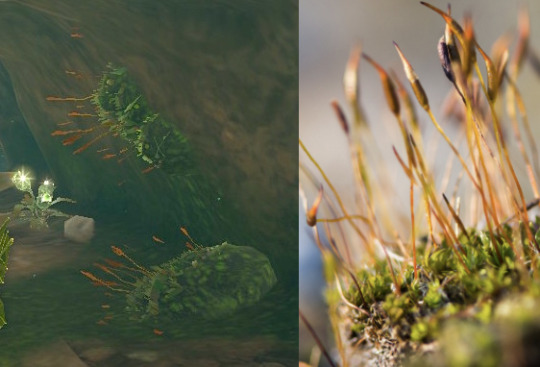

Real liverwort photo © Graham Calow, NatureSpotUK
Not yet spotted: Hornworts! Did they forget the third bryophyte sister :(
I think these next guys are probably lycopods (specifically club moss, which is not a true bryophyte moss, thanks science.) Very old, but vascular, so they're a bit more evolutionarily recent than bryophytes.
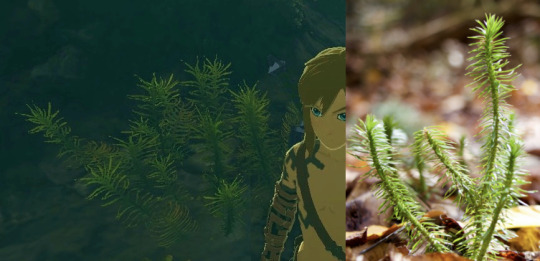
Real photo © Gloria Hanley Schoenholtz, virginiawildflowers
All the enormous curly-topped trees in the depths: Ferns! They curl like that until they unfurl. Another very old plant, though younger than bryophytes and lycopods.
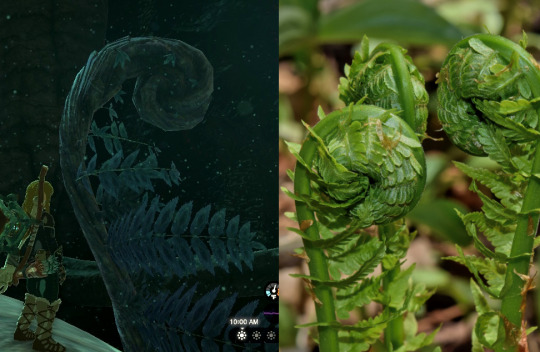
Real photo via The Cosmonaut, Wikipedia
Brightblooms and some of the other giant plants in the depths: Possibly based on a cycad? Again, a very ancient plant lineage. At this point, evolutionarily, they've developed seeds—that giant cone in the center is called a strobilus, and that's the seed structure.
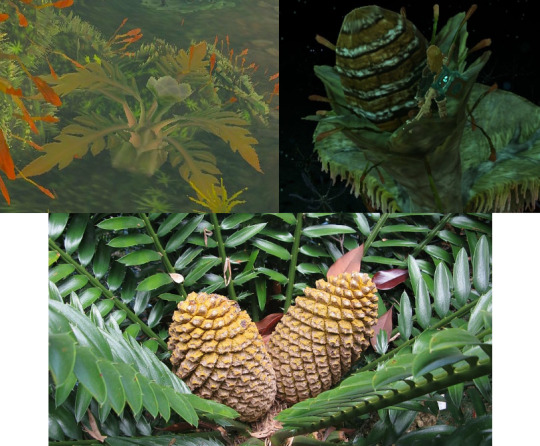
These next few plants are angiosperms, meaning they produce flowers. Angiosperms are a more recent evolutionary lineage—still many millions of years old, but it took a while to develop flowers as a reproductive tactic.
Sundelions (left) are a fun recolor of a lily. There are also some scenery lilies (right) in various places—there are yellow ones that spring up when you turn on a lightroot (which gives them literal and thematic connection to the surface) and several other varieties, including tiger lilies, throughout Hyrule. Fun note, the sundelions appear to only have 5 stamen, while other lilies in the game (correctly) have 6. Seems to be an intentional decision to make it a more distinct fantasy species.
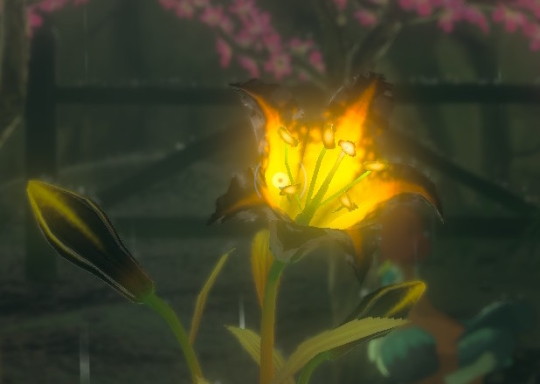
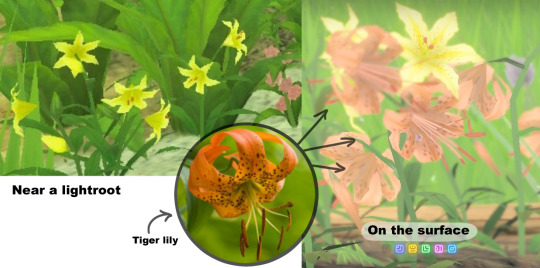
These next ones are Peruvian lilies/Alstroemeria, just used as a scenery plant but a very fun inclusion. Fun fact, not true lilies, so they're not deadly to cats like true lilies are.
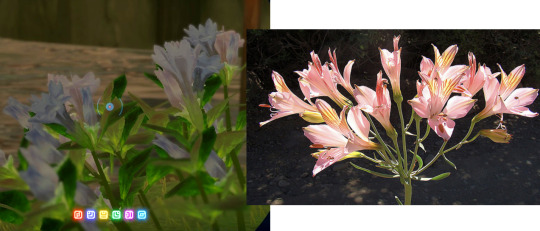
Real photo © Dick Culbert, Wikipedia
Plum trees: These are also called out as plum trees in game! There's a journal in Kakariko that refers to the plum orchards.
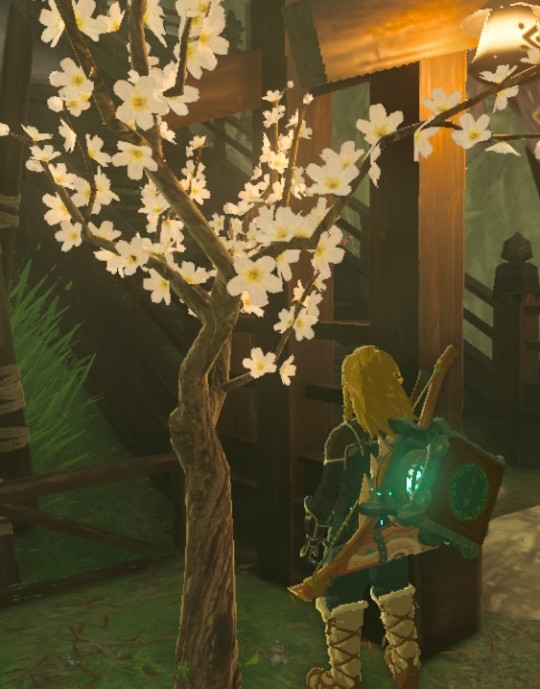
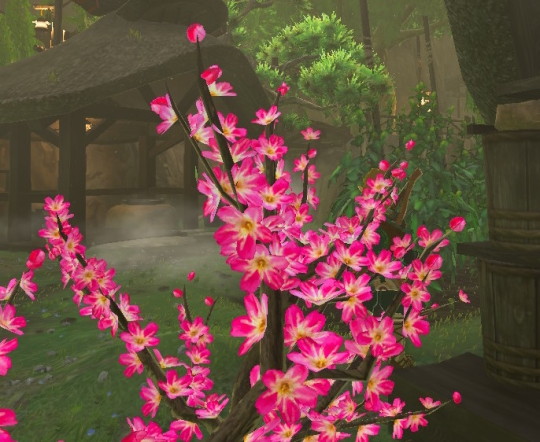
Okay I'm a little proud of figuring this one out. Bomb flowers blend a few botanical references. Superficially, the fruit resembles a type of seed pod called a capsule—specifically it's very similar to a poppy capsule. The little red thing in the center is a nice addition to resemble both a flower stigma (reproductive part that leads to the ovary) and a bomb fuse. Now, poppy capsules disperse their seeds via wind, but there are other plants who do explode their seeds outwards as a dispersal tactic! This is called explosive dehiscence.
There is one tree in particular called the sandbox tree, AKA monkey-no-climb or dynamite tree (yes, really.) Their capsules look more like little pumpkins, but are known for violently exploding when ripe—they can launch seeds at 150 miles per hour (250 km/h) and spread them roughly 200 feet (60 m) away. The photo comparison is a poppy capsule but you should def go look up dynamite tree videos.

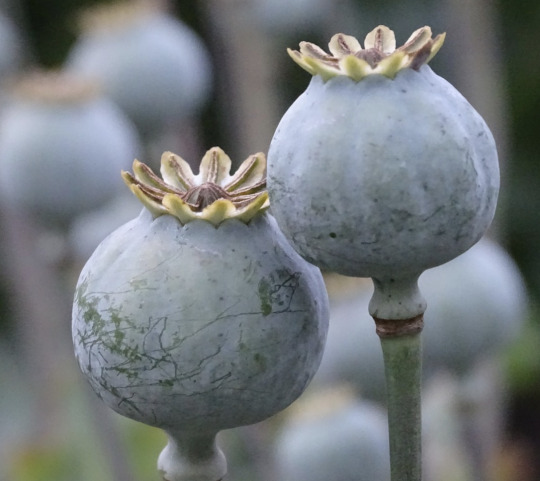
Real photo © PommeGrenade, pixabay
Fire fruits (and the other elemental fruits) grow on the same generic plant that looks kind of like it has grape leaves. Fire fruits resemble a specific botanical thing too though—the black netting is a papery calyx (part of the flower) seen in a nightshade genus, Physalis (golden berries, tomatillos, etc.)


Real photo © Helene Rogers, Alamy
I think this stuff is an Asarum, AKA wild ginger. I was actually puzzling over it until I walked past some today and went HEY
Not sure of the exact species but they're very green and heart-shaped and love being dense and low to the ground.
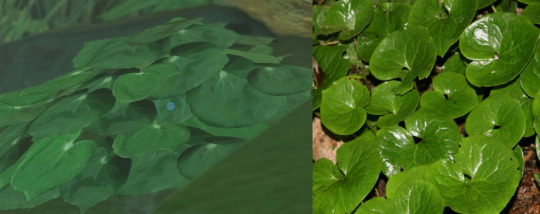
Real photo via David Stang, Wikipedia
Irises: Love irises, one of my favorite flowers and words, very happy to see them in game.

MISCELLANEA
Cup lichen! Lichen is not a plant, but a symbiotic structure of an algae + a fungi. Cup lichen is just a type of lichen formation that has a kind of vertical cup-like structure.
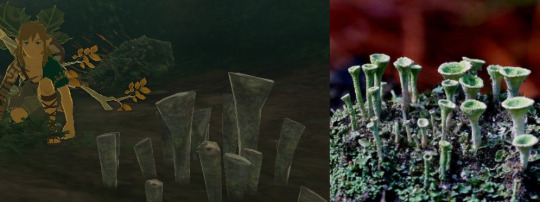
Real photo via Bernard Spragg
Geology crossover! Go look carefully at some of the whiter walls in the depths—they look like they have fossils of coral and other undersea hard-structured animals in them.
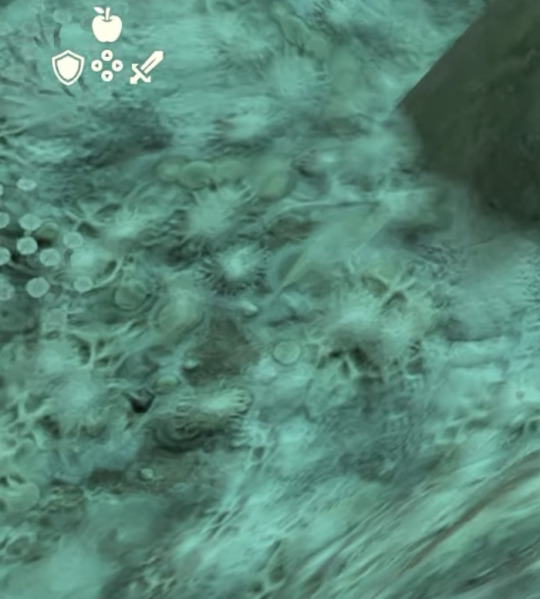
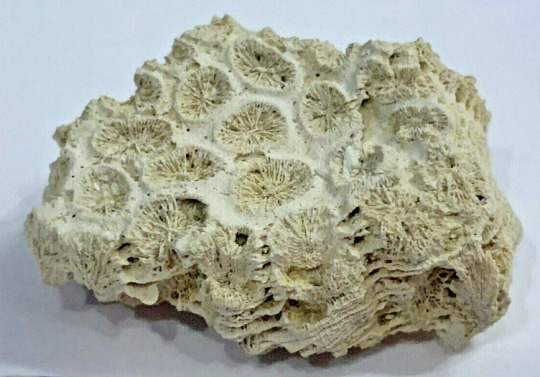
ANIMALS
Sticky lizards: Based on Diplocaulus, a very early (now extinct) amphibian! Their skulls are wacky. We're not sure whether the long sides stood out separately or were smoothly connected to the body by skin flaps, but the separate arrow-like shape is the most popular rendition.
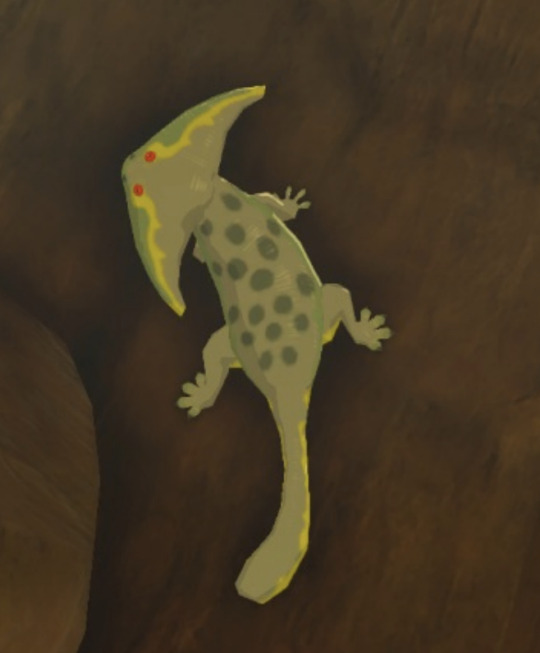

Deep firefly: Might be a stretch because it could just be a multi-winged fantasy critter, but I think the "wings" and antennae are very reminiscent of Anomalocaris, an ancient aquatic arthropod.
Update: Other folks in the notes/tags have pointed out that they're probably based on a cryptid that's especially popular in Japan: skyfish AKA rods! They show up in photos and people think they're an alien lifeform. In reality, they're an optical blur created when a lower quality video captures intermittent flaps of an insect's wings, leaving sort of a many-winged smear in the photo. Thanks to all who left info!
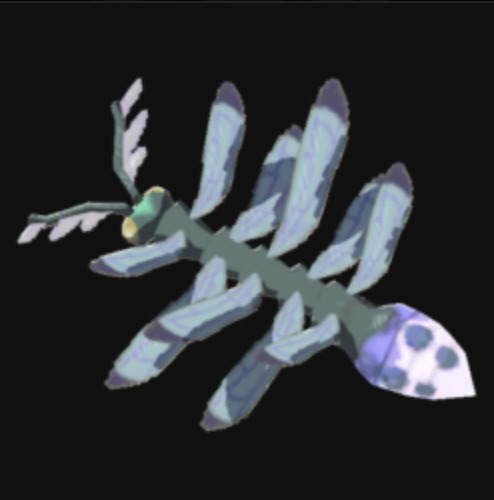
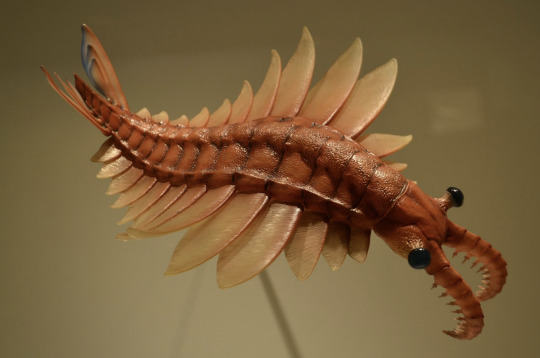

Little frox: Another stretch because it totally could just be a Hinox-like frog, but every time I see the little ones I can't help but think of like...Ichthyostega, Mastodonsaurus, Eryops, and other early amphibians. They were pretty hefty—little frox size or bigger—and had with little waddling legs. This is less "I think it's definitely this" and more "it makes me happy when I picture frox as primitive amphibians."


I haven't detailed many of the scenery animals around Hyrule because most are identifiable with the camera function—it'll tell you that a certain animal is a heron or porgy, for example, and those groups are real, even though the exact species is made up. But I think the pigeons are fun because they're all crested pigeons. Pink-necked green pigeons may have also been the inspiration for the color palettes on the wood and rainbow pigeons.
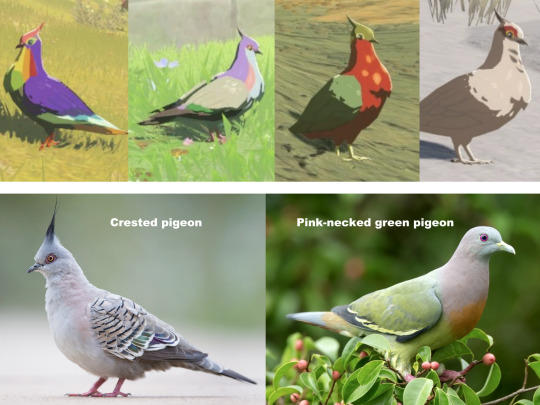
Both pigeon photos via JJ Harrison, Wikipedia
Spiny bones: Not a specific critter, but those spiny bones that you can find lying around Eldin Canyon are vertebrae—possibly from the same thing that left those big rib cages around? The top spike is the spinous process where muscles attach, the littler spikes on the side are the transverse and articular processes. The dark O in the center is the spinal cord.
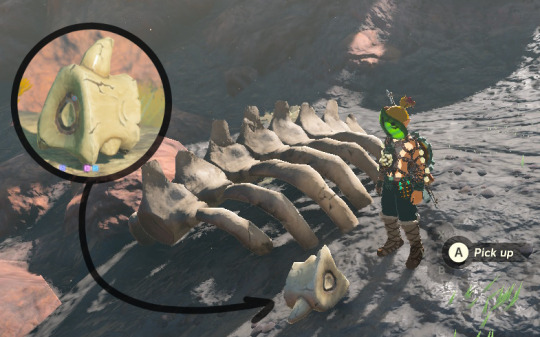
Also I made a friend who finally recognizes my purpose in Hyrule.

That's all I've got for now! Will add more as I keep playing.
#tears of the kingdom#totk#legend of zelda#loz#science fun#biology#lizard#plant#botany#image heavy#long post
7K notes
·
View notes
Text
I think we all know what my opinions on mosses are here 😈
Reblog if you love moss

#moss#mosses#moss post monday#moss posting#plants#botany#bryophytes#non vascular plants my beloved#the answer is yes#i fuckign love moss#like you have no idea
17 notes
·
View notes
Text

791 notes
·
View notes
Text
nonvascular plants are sooooooo gender
2 notes
·
View notes
Note
what exactly is a nurse log?
Nurse Boles:
On the Magic of Decaying Trees

Something very sacred in the context of my work is the Nurse Bole; the trunk of a dead tree, which has become a source of new life as it rots. Generally speaking, there are two kinds of Nurse Bole—known as Nurse Logs and Nurse Stumps— though, they only really differ in technicality.
A Nurse Log is a fallen tree which, as it’s left to decay, provides a rich environment for the facilitation of new ecological growth. These logs often support a wide variety of synergistic flora, making them an important, if often overlooked, variable within the larger tapestry of forest ecology. Not only do they provide a growth medium for a variety of lifeforms—such as seedlings, ferns, bryophytes, and mycorrhizae—they also provide new growth with moisture, moderated access to sunlight, and a degree of protection from pathogens.
In the same vein, a Nurse Stump is a tree stump which, when left to decay, provides a similarly rich environment for new growth. As they rot, the tops of these stumps become fertile habitats for the sustainment of new shrubs and trees which, in turn, supplant their hosts with time.
Each of these are extremely significant within the context of the Wending Way for so powerfully embodying the ouroboric union of life and death. As such, offerings secreted within, and ceremonies conducted in the vicinity of, Nurse Boles are considered especially propitious. Likewise, plants and wood harvested from the body of a Nurse Bole are considered uniquely potent, as well as waters collected from within the hollows of their trunks, since all materials gathered from a Nurse Bole contain and conduct a high concentration of both zoetic and thanatic virtues. In particular, this aforementioned water—which I sometimes call Nurse Water—is quite well suited to the context of Spirit Work (beloved, as it is, by sundrie Wights) and as a fortifying agent in works of ceremonial magic. It is also powerfully well suited to acts of healing magic, which can be gleaned in the traditional beliefs surrounding Stump Water in North American folk-magic and folk-medicine.
—
[Art Credit: Lucien B. Hale]
#anonymous#ask#nurse log#nurse stump#nurse bole#decay#rot#green magic#plant magic#thanks for the good question! :~)
1K notes
·
View notes
Text
Before Monocots and Eudicots: The Basal Angiosperms
Originally posted at my blog at https://rebeccalexa.com/basal-angiosperms/
One of the nice things about living on a lake is that I can go kayaking whenever I feel like it–or, more realistically, when I have the time to do so. I hope someday to be the kind of person who can start every day with a serene glide across the water, but for now I take my opportunities as I’m able to. One of my favorite things about the experience is getting to start and end my journey by paddling through a huge patch of western yellow pond lily (Nuphar polysepala, previously categorized as a subspecies of Nuphar lutea). And it was this plant that was my introduction to the concept of basal angiosperms.
See, when I have a species I really like, I spend time researching it. So I decided to dig into the natural history of this plant, one of eight extant species in the genus. In addition to finding out that the seeds are edible, and the roots are a traditional medicine, I also learned that they are an example of basal angiosperms–something that piqued my interest in tracing the evolution of various beings.

Nuphar polysepala
Basal angiosperms are essentially the oldest orders of flowering plants. Prior to the first angiosperms, plants either reproduced with cones like today’s conifers and other gymnosperms, or through spores and gemmae as with bryophytes (which may also reproduce through fragmentation.) Flowers were a new mutation that used visually appealing structures and scents to attract animals as vehicles for spreading pollen to other members of the same plant species. Flower-producing plants–the angiosperms–have since exploded into countless species, with about 300,000 known species in existence today. The most ancient lineages are known as ANITA grade.
ANITA is short for a group of five orders: Amborellales, Nymphaeales, Illiciales, Trimeniaceae, and Austrobaileya. More recently Illiciales and Trimeniaceae have been folded into Austrobaileya, leaving the acronym shorter at ANA, though some recent papers persist in using ANITA.
Angiosperms are commonly thought to have evolved during the early Cretaceous Epoch, around 135 million years ago, though pollen that may be angiosperm in origin was found dating back to about 250 million years ago. Soon after angiosperms appeared, their lineage began to branch out. The earliest branches to diverge were the basal angiosperms. Amborella trichopoda is the sole representative of the oldest branch; all other flowering plants share the same common ancestor from which Amborella‘s ancestors diverged.

Amborella trichopoda. By Scott Zona, CCA-2.0
Amborella lives all the way on the other side of the planet from me, on the island of Grand Terre in New Caledonia, which means my chances of getting to see it in person are pretty slim. However, there are lots of basal angiosperms out there, and they have some pretty interesting qualities.
If you learned about plants in middle school or junior high, you very likely learned about “monocots and dicots” as being the two main divisions of flowering plants. In truth, these two are joined by the basal angiosperms, and a fourth group, the Magnoliids. These latter Magnoliidae are the next-oldest group of angiosperms, and they and the basal angiosperms both pre-date the emergence of the monocots and dicots (now known as eudicots). Species in these older lineages have physical traits of both the monocots and eudicots, giving a glimpse of what flowers were like before these more numerous groups appeared. This also shows that monocots and eudicots have a common ancestry, rather than one evolving from the other.
The Nymphaeales, of which my beloved western pond lilies is a part, are a good example. If you examine the structure of a stem of a pond lily, it looks very much like that of a eudicot. Rather than having vascular tissue distributed throughout the the stem’s tissue as with a monocot, the vascular bundles are arranged in a circle like in a eudicot. But the stem lacks the eudicots’ cambium, which creates xylem and phloem.
Like the monocots, Nymphaeales flower parts are arranged in multiples of three, whether petals, stamens, etc. However, this does not mean the basal angiosperms are the direct ancestors of monocots. Compare Amborella which has varying numbers of tepals (the forerunner of sepals and petals), stamens, carpals and other parts depending on whether the flower is male or female. Neither sex of Amborella displays a trimerous (parts in multiples of three) flower. And, just for the record, eudicot flower parts generally show up in multiples of four or five.
The relationships among these various groups of flowering plants aren’t just dependent on the physical characteristics, though. A lot of what we’ve been learning lately about basal angiosperms comes through genetic research. For example, a recent debate concerns whether Amborella is the oldest basal angiosperm, or whether Amborella and the Nymphaeales together are the very oldest lineages, closer related to each other than the rest of the angiosperms.

Kadsura japonica
If you live in Australia, east Asia, or the Caribbean, you have species from the Austrobaileya in your region. Austrobaileya scandens is the only member of its genus and family, and is located in northeast Queensland. The Schisandraceae and Illiceaceae are woody plants found in tropical areas in east Asia and the Caribbean. While in tropical Southeast Asia, you might look for the Trimeniaceae, various species which may also be found in eastern Australia and the Pacific Islands. Amborella, of course, is limited to New Caledonia.
The Nymphaeales includes the better part of a hundred species, including the various water lilies, fanworts, and similar plants. They are quite widespread, found commonly (to include as invasive species in some cases) on all continents except for Antarctica.
As for me, I will continue to enjoy the presence of my local western yellow pond lilies. Now that I have a deeper understanding of their evolutionary history, I can better appreciate what unique neighbors they are!
Did you enjoy this post? Consider taking one of my online foraging and natural history classes, checking out my other articles, or picking up a paperback or ebook I’ve written! You can even buy me a coffee here!
#long post#botany#plants#evolution#prehistory#flowers#angiosperms#nature#ecology#science#scicomm#science communication
225 notes
·
View notes
Text
International Women’s Day 2019
Happy International Women’s Day! With so many amazing women working and volunteering at RAM, it’s hard to choose only three to profile! Today, we’d like to introduce you to Ellen Chorley, Michelle Weremczuk, and Brittney Miller.
What do you do here at RAM?
Ellen: I am an Admissions Associate, which means I am one of the first faces folks see when they come into the museum!
Michelle: I work at RAM as an exhibition designer, looking at the physical space of the gallery and thinking about how to utilize it to tell a story. My work often consists of laying out floorplans of the galleries, positioning objects in cases, drafting technical drawings for carpenters and prototyping designs before they go on the floor.
Brittney: Here at RAM, I am a bryophyte technician. The majority of my work involves dissecting and naming tiny mosses and liverworts (bryophytes) that the ABMI field technicians collect over the summer. On average, our team identify 17,000 plants annually, with over 250 unique species. Once named, the bryophytes become data ABMI uses for environmental health assessment, as well as a part of the RAM’s herbarium (PMAE) which is a resource for conservation, education, and research.

Michelle laying out 3D exhibit models
Tell us a bit about yourself and your background.
Ellen: I am a born and raised Edmontonian and my background is in theatre and writing. Along with my job at the RAM, I am have a full time job as the Festival Director of an annual multi-disciplinary arts festival for emerging artists called Nextfest (www.nextfest.ca). I also teach acting and playwriting with the Foote Theatre School at the Citadel Theatre and I am the Box Office Manager for Northern Light Theatre. Outside of my various jobs, I work as an actor, director and playwright. I was just commissioned to write a play for Vernon Barford Junior High School called “For the World to See,” and next January my play “Everybody Loves Robbie” will have its world premiere. I was named one of Avenue Magazine’s Top 40 under 40. In my spare time, I collect copies of the novel “Wuthering Heights” (I have 97 copies) and my beloved partner Pete and I have a polydactyl cat named Thumbs.
Michelle: I’ve lived in Alberta my whole life having a strong interest in art and design, and decided to pursue it in university. After graduating, I interned at the Royal Tyrrell Museum. A job was posted a few months later at the Royal Alberta Museum and I’ve been here ever since. That doesn’t stop me from getting out, though! I love going to galleries and museums whenever I have the chance.
Brittney: I started my undergraduate degree at the University of Alberta thinking I wanted to be a dentist or microbiologist. I took one introductory course on plants, realized how immensely fascinating plant research could be, and I entirely changed my direction. I completed my degree as a specialization in plant biology, and conducted research on gene expression in vascular plants, and regrowth biology of peatland and northern mosses. My work with mosses led me to fall in love with their intricate beauty and underestimated environmental significance. Following this new love, I pursued a master’s degree looking at the ability of ancient (4000 years old) Yukon moss to regrow. Through my research, I developed a passion for moss identification, which as a bryophyte technician for the RAM and ABMI I get to apply my skills and learn more every day!
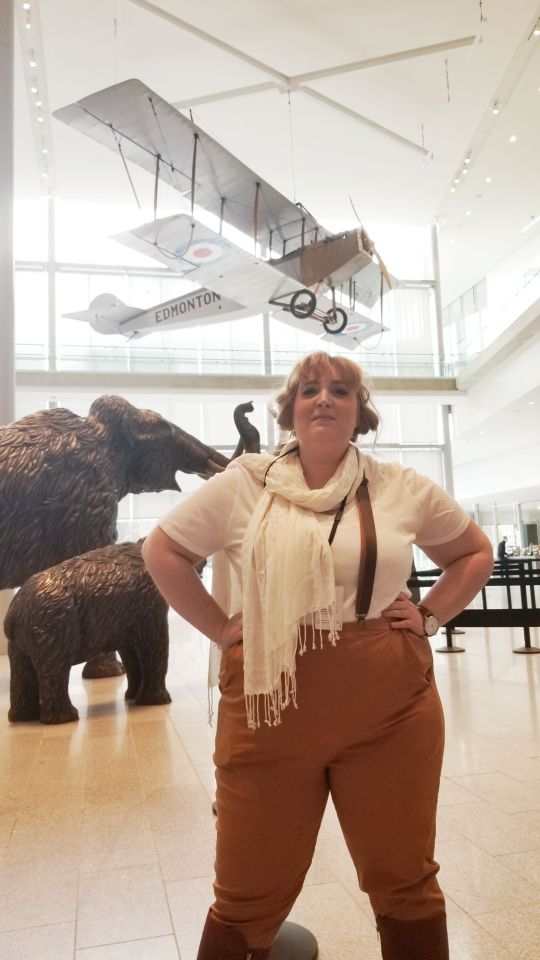
Ellen dressed as Wop May on Halloween 2018
What do you enjoy about working at the Museum?
Ellen: I absolutely love working here. I think it is so special to be part of the new building. I have enjoyed meeting folks who are coming to the museum for the first time. They bring such a sense of wonder with them, and I know that there is so much to discover at the RAM! I am also a big history fan, so I love working next to galleries full of Alberta’s rich past.
Michelle: I love that everyone is so passionate about the work they do! There are so many specialists under one roof with different viewpoints, you end up learning about all sorts of things you had no idea existed.
Brittney: As I learned more about plants throughout my university career, it became important to me to be involved with evoking appreciation for how integral plants are to our existence, including moss. So to me, science, and in particular working for the museum and ABMI, is an ideal career where I could pursue a thirst for knowledge, and be a part of an organization that recognizes moss as important part of biodiversity.
I also love the emphasis RAM has on sharing knowledge and passion. Within this past year alone, I conducted plant biology lessons for elementary school students with Alberta Science Network (ASN), was a speaker for the Women in Scholarship, Engineering, Science, and Technology (WISEST) for a women and girls in nature event, and ran a workshop for Sphagnum (peat moss) identification with my coworker, Teri Hill, for the Alberta Native Plant Council (ANPC).
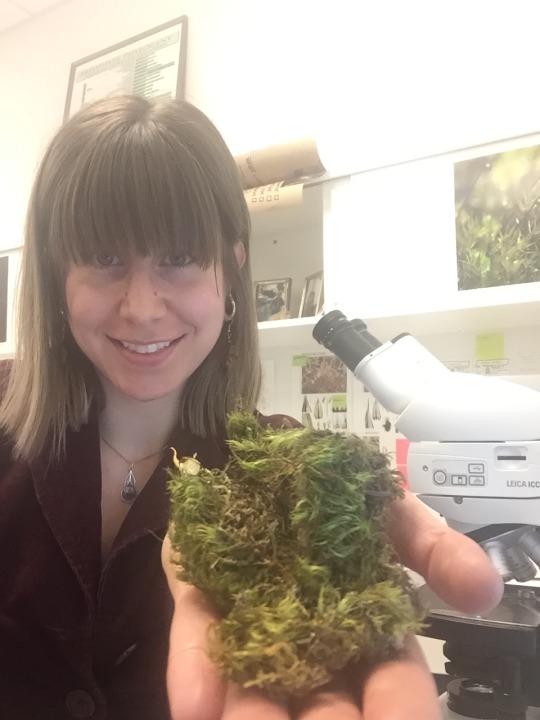
Brittney and a mossy friend.
What is one of the coolest things you have done in your life so far?
Ellen: I think I have had a pretty cool life, mostly because I get to work in theatre, an art form that I’m truly passionate about. I think the very coolest thing I’ve done (so far) was being in the western Canadian premiere of “Bat Boy: The Musical” in Calgary. At the beginning of the play, I had to repel from the top of the very tall set, all the way down to the stage. It was such a cool way to start the play and I loved learning how to rock climb and repel (though I always took a deep breath and crossed my fingers before I took that first leap off the set!).
Michelle: I love having pet projects, and one of my favourites is designing and laying out my garden every year. Last year I planted a LOT of cutting flowers. It is so neat to see how different plants grow and change over the summer, and I’m constantly excited to see what happens next.
Brittney: At the end of my master’s degree I had the opportunity to travel to Ellesmere Island (Canada’s North Pole) to study moss (yes, many species of moss thrive in the North Pole!). Shortly after that work, I joined the ABMI team at the RAM. The opportunity to be a part of and contribute to this world-class monitoring program has and continues to be incredible.
What advice do you have for young women today?
Ellen: I think my advice would be: Take risks. Even if you don’t get to where you thought, at least you tried — and trying is much better than not knowing!
Michelle: Find something that really interests you and go for it! You have a whole lifetime to learn.
Brittney: Passion is key. Find your passion, whether it is a field you’re interested in, or organism, or question, and say yes to any opportunity that comes your way that will allow you to purse that passion. There had been a shift in science where opportunity exists for those who have a strong work ethic, and relentless passion for knowledge, regardless of gender. And, most importantly, don’t be afraid to fail. There is an incredible amount of knowledge and growth to be gained in failure.
1 note
·
View note
Text
moss my beloved!!! fun fact: mosses are bryophytes, a much older branch of the plant family tree than, for instance, flowering plants! one of the implications of this is that for mosses, the gametophyte is the dominant life stage that you point at and say “moss” and the sporophyte is teeny tiny. This is the reverse of flowering plants, where the sporophyte life stage is what you point at and say “tree” and the gametophyte is teeny tiny, only existing in the flower and then turning into a fruit basically! A major difference is that sporophytes have two sets of chromosomes like humans do (there are exceptions), aka they’re diploid, and gametophytes have one, aka they’re haploid. I didn’t even KNOW that plants have two distinct life stages until recently!!! plants!!!
Yesterday I saw moss.
#DISCLAIMER: I am only in my 2nd year of my bsc#I saw moss and was reminded of my early bio labs and got excited#pretty sure I'm remembering all that right but#I can't remember the role of the moss sporophyte in reproduction and it's bothering me#plants#fave
135 notes
·
View notes
Text







Look upon my beautiful mosses and weep (tears of joy), for there is nothing better than these!!
#plants#botany#moss#mosses#moss post monday#moss posting#bryophytes#non vascular plants my beloved#i love these little moss terrariums so much!#and yes all these pictures of moss I've been posting are mine
54 notes
·
View notes
Text
GUYS, OH MY GOODNESS YOU WON'T BELIEVE THIS!!!!!

My moss box has slime mold!!!!!!!!!!!! 🥺
P.S. does anyone know how to move slime mold off of glass? I want to give her a terrarium all to herself (:
#moss#mosses#botany#moss posting#plants#non vascular plants my beloved#bryophytes#animals#slime mold#slime molds my beloved#look at it!!!!#i'm so excited guys#like you have no idea#i think i will call her edna#Edna my beloved 🥺❤️
45 notes
·
View notes
Text




Sphagnum moss galore!!!! 😈
#plants#botany#moss#mosses#moss post monday#moss posting#bryophytes#non vascular plants my beloved#sphagnum moss#i have so much moss#like you have no idea
12 notes
·
View notes
Text




More glorious sphagnum moss, the beautiful hues will tickle all the good senses in your brain! (:
#plants#botany#moss#mosses#moss post monday#moss posting#bryophytes#non vascular plants my beloved#sphagnum moss#i love red sphagnum moss#it is just so neat#it makes me feel things#happy things#just crying from joy guys 🥺😭
8 notes
·
View notes
Text
I just realized I forgot to moss post on Monday and I'm so unbearably ashamed with myself 😔
Just know that this is literally me right now

I'm so sorrrrrrrrrrryyyyyy
This art is not mine, I'm just using it to convey my emotions, it was created by the artist @laramieslims and is part of their piece "what if salmon just kept getting worse" (:
#not my art#plants#botany#moss#mosses#moss posting#non vascular plants my beloved#bryophytes#im so sorry guys#i kinda spaced out for four days and forgot time existed#im not smart
7 notes
·
View notes
Text



So many beautiful bryophytes my friends, I hope you do enjoy! C:
#plants#botany#moss#mosses#moss post monday#moss posting#bryophytes#non vascular plants my beloved#sphagnum moss#moss brings me so much joy#and i hope it brings you joy as well (:
10 notes
·
View notes
Text
Little friends will join us today in our great moss conquest 😈





#moss#plants#botany#mosses#moss posting#non vascular plants my beloved#bryophytes#bugblr#bugs#critters#little guys if you will#just some small friends#they will ravage the countryside!#i'm so proud of them#😭
2 notes
·
View notes